3 Tips for Improving Page Load Time and SEO Through Image Optimization
 The internet is a vast treasure trove of data, and the number and variety of websites covering every topic under the sun is mind-boggling. Without the help of search engines like Google, finding useful information online would be nearly impossible. This is why Search Engine Optimization (SEO) is so important; any business that wants to connect with their customers online needs to ensure that people will be able to find them in online searches.
The internet is a vast treasure trove of data, and the number and variety of websites covering every topic under the sun is mind-boggling. Without the help of search engines like Google, finding useful information online would be nearly impossible. This is why Search Engine Optimization (SEO) is so important; any business that wants to connect with their customers online needs to ensure that people will be able to find them in online searches.
When determining how to rank a site in search results, Google and other search engines look at a number of factors, but one of the most important of these is page load time. The amount of time it takes your site to load can play a major role in how people interact with the site, especially when they are using a mobile device. According to Google, 53% of website visits are abandoned if a site takes more than three seconds to load, but on average, mobile landing pages take 22 seconds to load.
Since Google emphasizes the importance of a site’s loading speed, it is essential to do everything you can to improve load times. One of the best ways to do so is through image optimization.
Reducing Image Size
The images on a website are often the main culprit for slow load times. Ideally, the total size of all the data on a single website page should be no more than one megabyte, but a single unoptimized image can often be several megabytes in size. These tips will help reduce the size of images on your site, improving load times and having a positive impact on your SEO:
- Resize images - The photos taken by a typical smartphone camera are at least eight megapixels in size, which gives them the dimensions of 3456 by 2304 pixels. While most websites do not need images that are this large, many sites use overly large images that are resized using HTML or CSS code. Resizing image dimensions so that they are no larger than the space needed is a great way to cut them down to a more usable size. You can use a photo editing program to adjust the dimensions of large images and replace them with smaller versions.
- Use the correct file type - Images come in different types, and it is important to use the correct type of file for each image. For photos, a JPG file will provide good image quality while compressing files into a usable size. A PNG file is best for logos or line art, and it can include a transparent background. A GIF file should only be used for animated images since it has poor compression.
- Compress images - Even when the correct file type and dimensions are used, images can sometimes be overly large. In these cases, there are a number of utilities, such as TinyPNG, that can compress images, reducing their file size without sacrificing quality.
Contact the SEO Professionals at OVC
While reducing image size and improving page load times can have a positive impact on your site’s SEO, there are many other factors that affect your site’s rankings. If you want to know more about how the SEO experts at OVC can help you connect with your customers online, contact us online or call our office at 630-635-8000.
Sources:
https://www.thinkwithgoogle.com/marketing-resources/data-measurement/mobile-page-speed-new-industry-benchmarks/
https://searchengineland.com/images-easiest-page-speed-win-269742
https://searchengineland.com/big-small-5-free-image-compression-tools-reviewed-282478






